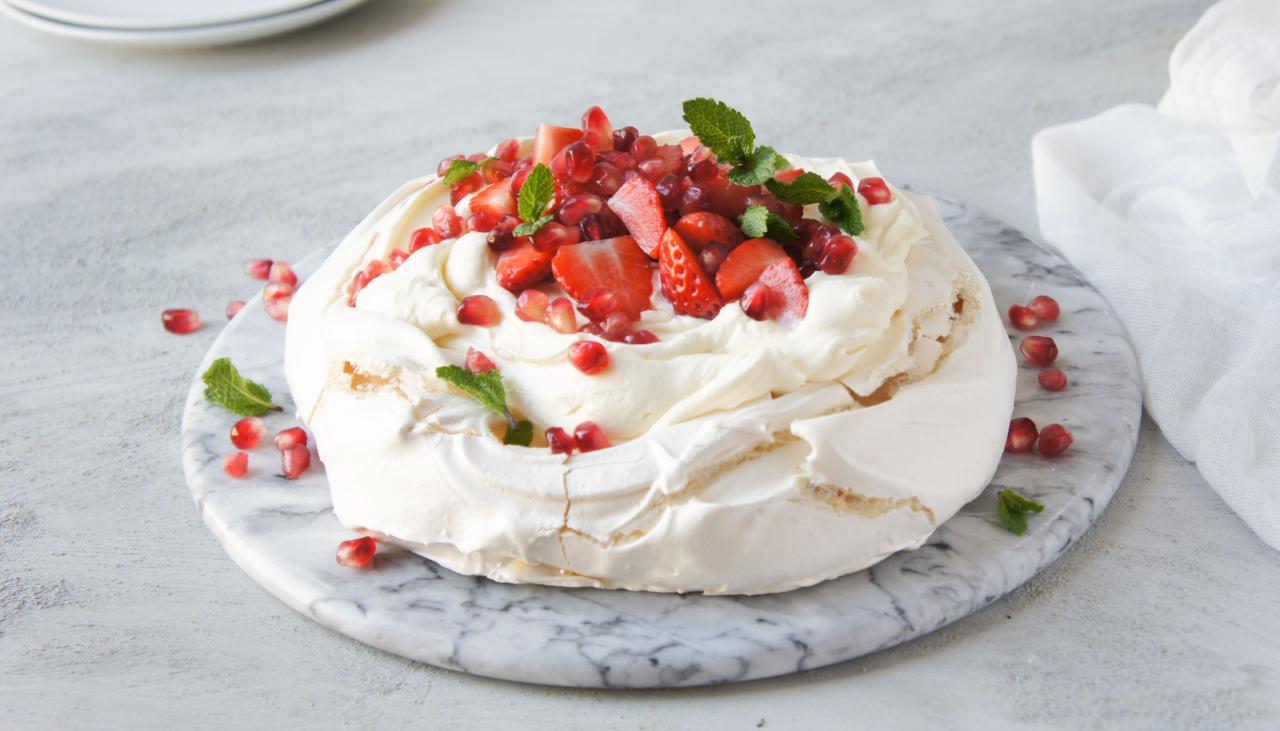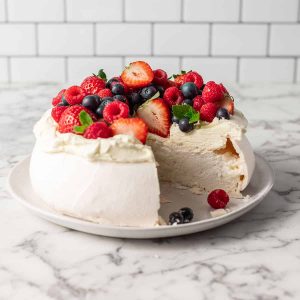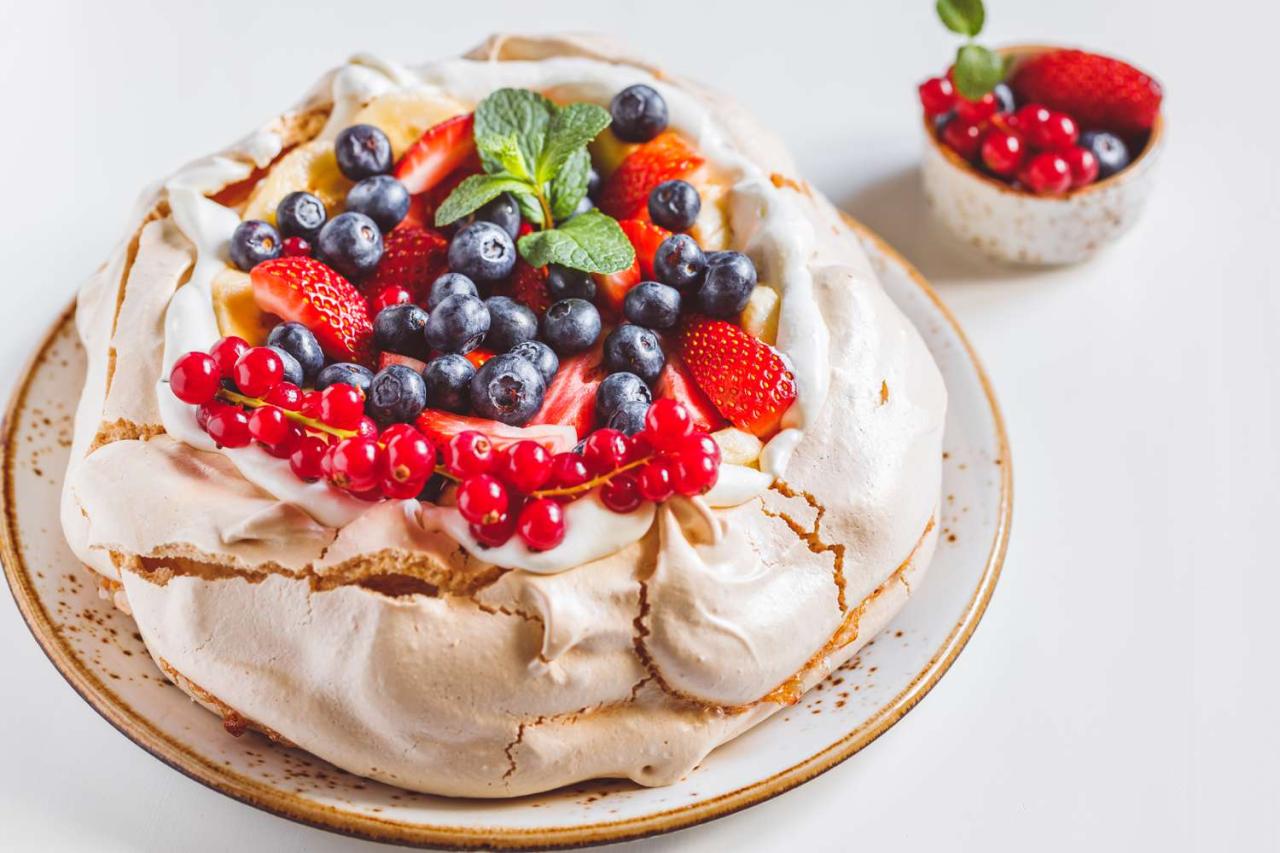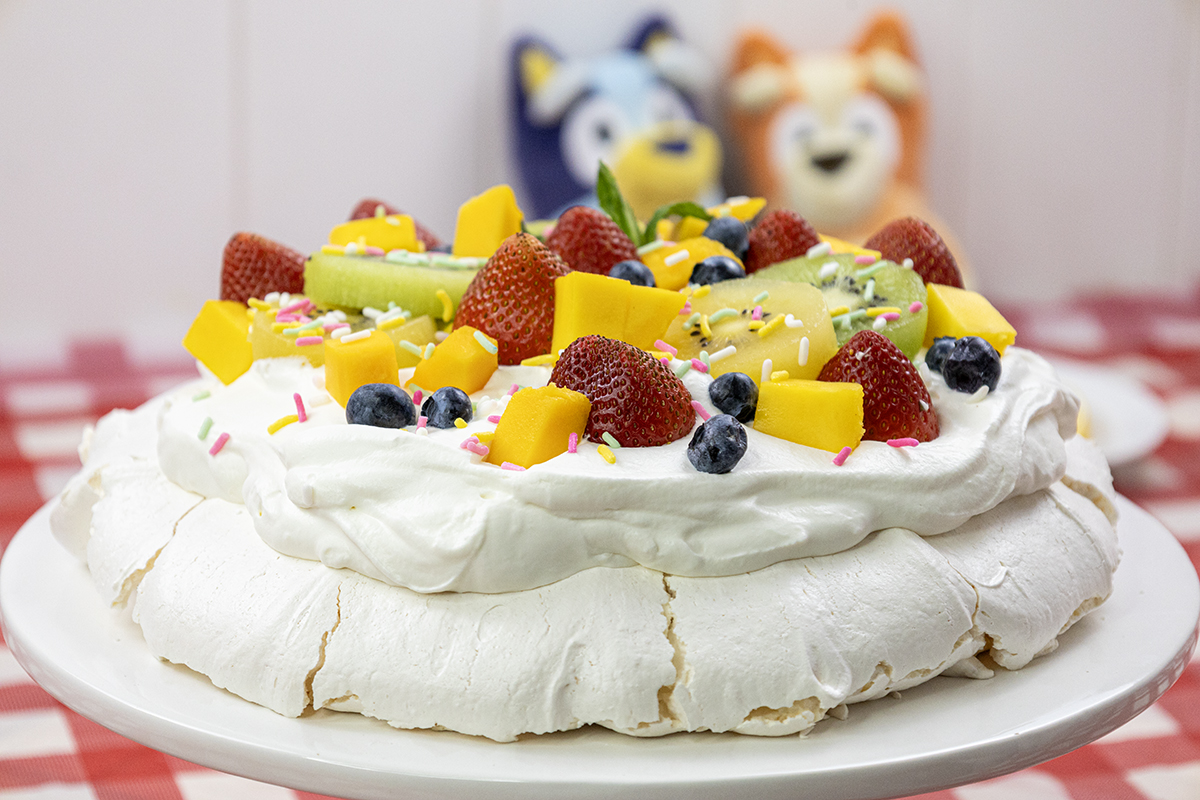Pavlova—a dessert that is as enchanting to the eye as it is to the palate, a cloud of meringue that promises a texture both crisp and marshmallow-soft. In the realm of sweet creations, the Pavlova holds a special place for its elegance and its whimsical charm. As a devotee of desserts that speak to both sophistication and simplicity, I find myself returning to the Pavlova when I wish to capture the essence of celebration in a single dish.
There are moments, often on the cusp of spring or at the height of summer, when the desire for something light yet indulgent guides my hands in the kitchen. The Pavlova, with its airy meringue base, crowned with a lush layer of whipped cream and adorned with an array of fresh fruits, is the embodiment of this yearning. It’s a dessert that seems to float on the plate, each bite a harmonious blend of textures and flavors that celebrate the season’s freshest offerings.


Pavlova
Equipment
- oven
- 1 large bowl
Ingredients
- 3 egg whites
- 1 pinch salt
- 1 tablespoon cornstarch
- 1 teaspoon lemon juice
- 1 ½ cup heavy cream
- ½ cup icing sugar
- 1 pint strawberries
- 6 kiwi fruit
- 1 tin passion fruit pulp
Instructions
- Preheat oven to 300 degrees F (150 degrees C). Line a sheet pan with parchment paper. Draw a 9-inch circle on the parchment. An easy way to do this is to draw around the outside of a 9-inch pan with a pencil.
- In a large bowl, beat egg whites on high speed until soft peaks form. Add 3/4 cup of the sugar gradually, while continuing to whip. Make sure sugar is completely dissolved. Mix together the remaining 1/4 cup sugar with the cornstarch; lightly fold into meringue with lemon juice.
- Spread a layer of meringue to fit circle on parchment, approximately 1/4 inch thick. With remainder of mixture, pipe or spoon swirls around the edges to form a shallow bowl shape.
- Bake at 300 degrees F (150 degrees C) for 1 hour. Turn off oven, but leave meringue in oven for an additional 30 minutes. When cool, the meringue should be hard on the outside, and slightly moist on the inside.
- In a large bowl, combine the cream and half a cup of confectioner’s sugar, and whip until thickened. Decorate with fruit of your choice; sliced strawberries, kiwi fruit, and passion fruit pulp are what KO uses.
Video
Notes
Cooking Tips

Pavlova is a dessert that captures the imagination with its ethereal beauty and delightful contrasts in texture. Crafting the perfect Pavlova is akin to creating a piece of edible art, where precision and a gentle touch are as important as the ingredients themselves. As someone who revels in the delicate dance of dessert-making, I’ve come to cherish the process of perfecting this meringue-based masterpiece.
One of the most crucial tips for making a Pavlova is to ensure that your egg whites are at room temperature before you begin whisking them. This small detail makes a significant difference, allowing the whites to reach their full volume potential. The act of beating the egg whites into stiff peaks is both therapeutic and critical; it’s the foundation upon which the Pavlova stands, quite literally.
Humidity is the nemesis of meringue, so choosing a dry day to embark on your Pavlova adventure can save you from the heartache of a weeping dessert. If the weather isn’t cooperating, a dehumidifier in the kitchen can be a savior, helping to create the right environment for your meringue to crisp up beautifully as it bakes.
The addition of an acid, such as cream of tartar or a dash of vinegar, is another secret to achieving a stable and glossy meringue. It’s a small step that speaks volumes in the final texture, ensuring that the outer shell shatters delicately between your teeth, giving way to the soft marshmallow interior that is the hallmark of a great Pavlova.
Baking the Pavlova is a slow and low affair. Patience here is a virtue, as the meringue needs time to dry out without taking on too much color. It’s a process that can’t be rushed, and the anticipation that builds as the Pavlova bakes is part of the joy. Once out of the oven, resist the urge to immediately move it; let it cool gradually in the oven with the door ajar to prevent cracks from forming.
When it comes to topping your Pavlova, balance is key. The sweetness of the meringue pairs wonderfully with slightly tart fruits like kiwi, berries, or passionfruit. The whipped cream acts as a cloud-like cushion, but remember to whip it to soft peaks—too stiff and it loses its luxuriousness.
In every step of making a Pavlova, there’s an opportunity to pour your emotions into the creation, to infuse it with care and attention that will surely be felt by those who take a bite. It’s a dessert that demands respect but rewards you with a sense of accomplishment and the joy of sharing something truly special.
The Best Way to Serve Pavlova

Serving a Pavlova is akin to presenting a piece of art at an exhibition; it’s the moment where the creator’s vision and effort are finally showcased for all to enjoy. The Pavlova, with its crisp meringue shell and soft, airy center, adorned with a crown of fresh cream and vibrant fruit, is a dessert that commands attention and admiration. When I bring this dish to the table, there’s a palpable sense of anticipation in the air, as if the dessert itself is a celebration waiting to happen.
I find that the Pavlova is best served on occasions that feel just a little bit special, where its elegance can truly be appreciated. It’s a dessert that doesn’t just conclude a meal but elevates it, turning an ordinary gathering into a memorable event. As I slice through the delicate meringue, breaking into the cloud-like interior and scooping up a perfect mix of cream and fruit, I’m reminded of the joy that comes from sharing something made with care.
The choice of fruit topping can reflect the season or occasion—bright berries in the summer, exotic passionfruit or kiwi for a tropical twist, or pomegranate seeds for a festive touch. Each fruit not only adds its own flavor profile but also contributes to the visual feast that is a well-assembled Pavlova. A light drizzle of fruit coulis or a sprinkle of powdered sugar can be the final flourish that completes the dish.
In serving the Pavlova, I encourage guests to take a moment to appreciate the contrasts in texture and flavor—the crunch of the meringue against the softness of the cream, the sweetness balanced by the tartness of the fruit. It’s a dessert that invites you to pause and savor each bite, creating a shared experience that lingers long after the plates have been cleared.
FAQs

Can I make Pavlova ahead of time?
Yes, you can prepare the meringue base a day in advance. Store it in an airtight container at room temperature. Assemble with cream and fruit just before serving to maintain texture.
Why did my Pavlova crack?
Cracking can occur due to temperature changes. To minimize this, cool the meringue slowly in the oven after baking. Avoid opening the oven door too often during cooking and cooling.
How do I prevent the meringue from weeping?
Ensure that all utensils are completely clean and dry. Any trace of grease can prevent egg whites from achieving the desired volume. Also, bake the meringue at a low temperature and avoid humid days.
What fruits work best on a Pavlova?
Use fruits that contrast and complement the sweetness of the meringue and cream. Berries, kiwi, passion fruit, and mango are popular choices for their vibrant flavors and colors.
Can Pavlova be frozen?
Freezing is not recommended as it will alter the texture of the meringue. However, leftover Pavlova can be repurposed into Eton mess by mixing with extra fruit and cream.
As we draw the curtain on our Pavlova journey, it’s evident that this dessert is more than a mere confection; it’s an expression of culinary artistry. The Pavlova, with its ethereal layers of meringue, cream, and fruit, stands as a testament to the beauty that can be achieved when simple ingredients are transformed with passion and precision. It’s a dessert that captures the imagination and invites us to indulge in a moment of pure, unadulterated pleasure.
For those inspired to continue their exploration of the culinary arts, I encourage you to visit Foodies of New England. Here, you’ll find a community that shares your enthusiasm for dishes that not only taste exquisite but also tell a story. From the rustic to the refined, the pages of Foodies of New England are filled with recipes, insights, and narratives that celebrate the region’s rich gastronomic heritage.
In conclusion, the Pavlova is more than just a recipe—it’s a celebration of craftsmanship, a joyous ode to the ingredients we love, and a reminder of the shared experiences that food can foster. As you venture forth from this post, may you carry with you the inspiration to create, to experiment, and to find joy in every dish you craft. Let the Pavlova be a symbol of the sweet discoveries that await in your culinary adventures.